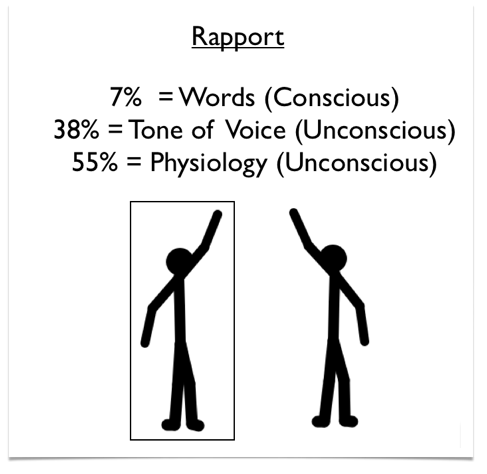One of the major things that master communicators all have in common is the ability to get into rapport with their audience. Whether you are communicating on a one to one basis or if you are communicating to a group. Whether it be in education, business or therapy, rapport is a very important process. In Hypnosis rapport is the state where the person being hypnotised accepts what the hypnotist says uncritically at an unconscious level, accepts the suggestions that are given uncritically.
NLP considers rapport as a process. In fact rapport was not really talked about much before NLP. NLP looks at providing a process to enable you to consistently get into that state for energetic connectedness with someone.
As it does with most things, NLP looks at building rapport as a process. What process do you need to go through to get in rapport with someone? How do you get into that state where your suggestion is accepted uncritically by the people to whom you are communicating? That sounds like an almost magical state doesn’t it? Where the subject really listens to you uncritically.
Rapport is where, when you are communicating with someone, you are actually communicating directly with their unconscious mind. Rapport takes your communication directly into the unconscious mind of the client.
The NLP theory of rapport was based on a study done in 1970 by a chap called Ray Birdwhistell. Birdwhistell noted in his study that in terms of communication, only about 7% of the communication ends up being the words that we use and a massive 38% of our communication is communicated by our tone of voice, and an even bigger 55% of our communication is communicated by our physiology. That is the physiology that we use when we are communicating For example, how we are standing.
Now, I bet you thought that your words were important? Well, they are important. In fact that is how we go about asking someone to do something. However alot more, actually 93% of what we communicate is communicated unconsciously, to the unconscious mind. People listen to our words consciously, but they listen to our tone of voice and physiology unconsciously.
So, this means that the vast majority of what we communicate, we communicate unconsciously to people. If we are communicating unconsciously then we want to be able to use our unconscious communication (communication that is out of awareness) deliberately to get maximum impact. That is consciously use unconscious communication.
The question is how do you begin to be able to consciously get in rapport with someone at the unconscious level? How do you consciously establish communication with the clients unconscious mind? That is the key for rapport.
The way that you do it is to become like them. It is a known fact that when people are like each other then they like each other. It is a process of responsiveness, it is a process of communication where we find common ground.
Usually when you are getting to know someone you will both search for subjects to talk about where you have something in common, whether it is the football team that you support, where you live, where you go on holiday, your cars, something that you both have in common, where you feel that the conversation will be easy. This is consciously seeking common ground.
In NLP rapport is more like unconsciously seeking common ground. Its when, for example you match and mirror someone then you are doing it out of their awareness in order to establish that common ground. Where the unconscious mind can look across at you and say, “ah yes, that person is just like me.”
We look in detail at how you know that you are in rapport and the process of building rapport in our NLP Practitioner NLP Training Course, communication skills training courses, and redundancy retraining courses. You can attend a UK NLP Training Course, or you can train in NLP online at our NLP online training platform.

